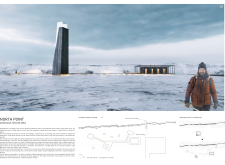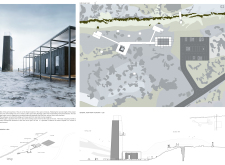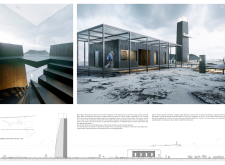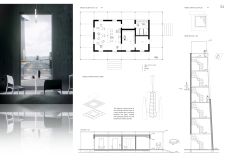5 key facts about this project
The site in Grjótagjá, located in the Mývatn area of Iceland, features a thoughtful design that connects the built environment with its unique geological context. Two main structures—a visitor's center and an observation tower—are central to this project. These buildings are designed to enhance the experience for visitors while respecting the surrounding landscape. The concept focuses on integrating architecture with nature, showcasing the area’s tectonic characteristics and volcanic features.
Site Integration
The design carefully blends with the local environment. The visitor's center stands as a regular-shaped volume, and vertical window openings create a rhythmic pattern across its facade, drawing attention to the natural surroundings. In contrast, the observation tower is more sculptural, formed by the intersection of two volumes: one solid and one transparent. This combination not only provides a striking visual appeal but also allows natural light to fill the interior spaces.
Pathway System
A key aspect is the use of lifted pathways. These pathways, made from perforated metal sheets, hover above the ground, allowing visitors to explore the area without damaging the delicate landscape. They connect the observation tower, the visitor's center, and the nearby Grjótagjá caves. This arrangement encourages a natural flow throughout the site, enabling visitors to engage deeply with the environment while keeping human impact to a minimum.
Architectural Features
The observation tower is strategically located near the cave entrances, serving as an important reference point for visitors. Inside, two viewing platforms provide expansive views of the surrounding tectonic divide, volcanic craters, and geysers. An interesting feature of the tower is the crack on its southeastern side, which invites light into the structure. This design detail offers visitors framed views of the landscape as they ascend the stairs, deepening their connection with the site’s natural beauty.
Materiality
The choice of materials is important to the overall design. Wood, steel, and glass are used throughout the project. Each material was selected for its ability to complement the natural environment. Wood offers warmth, steel ensures strength, and glass allows for transparency. Together, they enhance the relationship between the buildings and their surroundings, creating a cohesive experience for those who visit.






















































